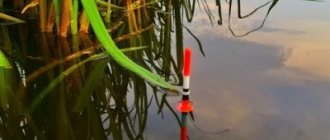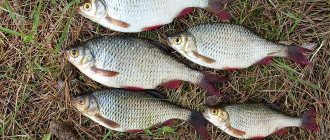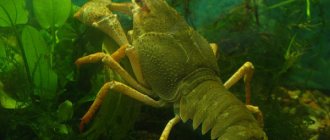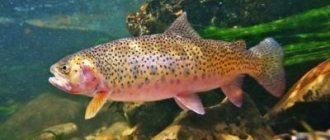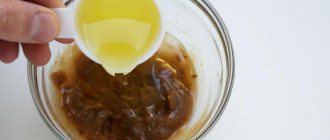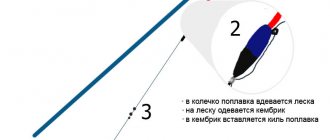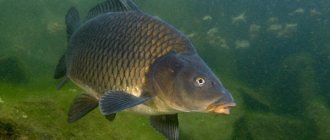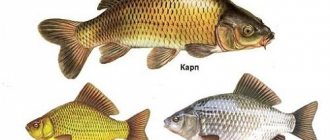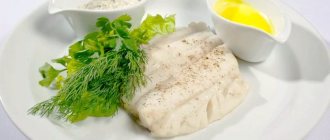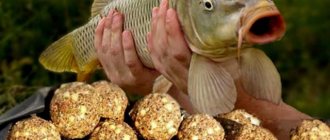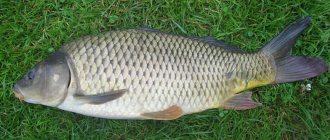Most carp anglers look forward to the beginning of summer, when carp begin to actively feed. In summer, baits of both animal and plant origin are suitable for carp. But carp is a cautious fish, and not many fishermen detect carp bites in time, which makes it impossible to catch this powerful fish. The whole point is that many lovers of float fishing rods do not have perfect carp fishing skills and make the same mistakes, which consist in the fact that fishermen do not take the preparation of bait seriously, as well as setting up their gear. Many fishermen do not bother looking for promising places and cast their fishing rods in a convenient place where the carp may not be located. In such cases, it is better to listen to the advice of professionals rather than waste time fishing.
Where is the carp in the summer?
When the water is heated to a temperature of +20ºС, the carp moves to a depth where the temperature is much lower and where it feels comfortable. Therefore, in the summer, you need to be prepared for the fact that carp will have to be retrieved from the depths. The most important thing here is to find a parking spot for the carp, otherwise fishing will be futile. Firstly, it is necessary to study the bottom topography in any available way, including using an echo sounder. You need to find several promising points, start feeding them and then start fishing.
Almost all fishermen are aware that fish move along their own paths and the main task is to find such paths, then half the battle will be done.
For those who like to catch carp from the shore, there are not many chances to do this in the summer, since carp only come to the shallows at night or early in the morning. If there are no bites during these periods, then you should start casting long distances. To do this, it is better to purchase a feeder rod, feeders and other accessories.
When to go fishing for carp in the summer?
It may seem strange, but the best carp bite in summer occurs during a thunderstorm, or before an upcoming downpour. Sensing danger, the fish tries to eat as quickly as possible, rushing at any easily accessible prey. If the first lightning flashes in the sky and thunderclouds gather above the horizon, grab your gear and go fishing.
But in rainy, windy weather the bite worsens. If there is a light breeze outside and the sky is covered with clouds, the carp will bite quite well.
Intense heat and similar cold temperatures reduce the activity of fish. At high temperatures, carp practically do not feed and spend all their time at depth. Sudden pressure surges and unstable temperatures also negatively affect the bite. Carp, like any other fish, loves stability.
The ideal time to go fishing is early in the morning before sunrise. A good bite of carp can be seen at sunset, right up to dusk. But still, in the early morning the carp bites much better than in the evening.
See also: CRITERIA FOR SELECTING A FISHING CHAIR
Summer fishing gear
To catch carp in the summer, fishermen have many options related to the choice of necessary gear. These can be ordinary float rods or bottom gear, including feeder ones.
Popular donks
You can fish with both traditional bottom gear, which fishermen have been using for many years, and modern, more advanced ones.
- Great master carp anglers use modern, more practical feeder gear. The feeder is a more reliable rod, which allows you to emerge victorious in a fight with this strong fish, especially a trophy one. Most carp anglers use electronic bite alarms, as it is very important to identify bites in a timely manner. A large specimen of carp is capable of “seizing” the gear from an unlucky fisherman.
- As a result of the use of conventional bottom gear, there are also losses, but the cost of manufacturing such gear is much less. The most interesting gear for bottom fishing may be:
- Spring;
- Pacifier;
- Makushatnik.
All of the above gear includes a rod, fishing line, reel, feeder and leash with hooks. They differ only in the design of the feeder, which affects the preparation of the type of bait: a more crumbly one is suitable for a spring, a more doughy one for a nipple. As for the top bait, this tackle is somewhat different in the technique of feeding bait. Here you can do without a feeder, since the bait is supplied to the fish in the form of a pressed piece of cake attached to the tackle.
When using such gear, it is unlikely that you will be able to see the moment of the bite. In such gear, the fish are caught on their own due to the weight of the feeder.
Float rods
There are fishermen who use classic float rods and can watch a motionless float for hours. Unfortunately, it is unlikely that you will be able to catch carp with a traditional float rod, especially a trophy one, since it requires some modernization.
- The match fishing rod is widely popular due to its effectiveness and affordability. Such a fishing rod can be equipped with a modern, lightweight, and at the same time, durable rod, strong fishing line, reliable reel and a sharp, powerful hook. Unfortunately, this is not enough and the quality of the equipment settings greatly affects the fishing efficiency.
- When fishing at distances of 10-15 meters, you can use more modern gear called a plug . Its basis is made up of separate knees, with which you can adjust the casting distance. Unfortunately, using the plug is not very convenient. Moreover, it requires a special stand. These are additional funds that not every fisherman has. This type of tackle does not have a reel and as much fishing line is tied to it as needed. When catching large fish, you need to use a rubber shock absorber to dampen the jerks of the fish, which will prevent the line from breaking.
Choosing hooks for catching carp in summer
When catching trophy carp, you should use only sharpened hooks, because... Dull models are not always able to pierce a fish's lip.
The size of the hooks must correspond to the size of the bait, so this factor depends on the individual characteristics of fishing. In the summer, hooks No. 1-3 are most often used for small baits. When fishing with larger lures, fishermen use models numbered 4-7.
Summer carp fishing is an extremely interesting and very productive activity. But to ensure yourself an unforgettable bite, you need to take into account a lot of different factors and features.
Source
Summer baits and groundbait
Many carp experts recommend going fishing with several types of bait, given the fact that carp are unpredictable. The following baits should be available:
- worms;
- bloodworm;
- boiled pearl barley;
- maggot;
- canned corn.
Currently, more and more preference is given to the use of boilies in catching carp, especially since in fishing stores you can find boilies for every taste. But this does not mean that fishing will not take place without them, especially in those reservoirs where carp are accustomed to ordinary porridge, cake or peas. In such cases, boilies may be useless because he will simply ignore them.
Catching carp in the summer, especially without bait, is a great success or an accident. When the water is warm, carp can accept both store-bought bait and homemade bait, but it is very important to know how to properly serve it to the carp.
Each portion of food sent into the water must have a special ingredient - flavoring. Having identified a promising location, they make an initial cast of bait, which is more than half of what is available. Subsequently, bait is added depending on the activity of the fish.
The following odorous ingredients can be added to working baits:
- anise;
- honey;
- halva;
- cocoa;
- garlic;
- cinnamon;
- vanilla;
- dry seasonings such as dill, parsley, etc.
But this does not mean at all that by adding one of the above-described flavors to the bait, you can count on catching carp. Unfortunately, it is difficult to guess the scent and if someone does it, then they are lucky. Carp can be attracted to one scent today, and tomorrow to another, and if fishing is carried out on an unknown body of water, then this problem is felt very noticeably. If boilies are used, they can be treated with dips, that is, special attractants.
The best and most effective option is to create an artificial “table” for the carp, to which it will come to feed, but this can take a lot of time and one weekend is not enough for this.
Rod and reel set
Fishing for carp requires the use of powerful rods and reels that can cope with the resistance of large fish. Even in light class gear there are series specially designed for extreme loads when fishing. It is better to choose reels with a low gear ratio, as they have more traction.
Rod classes
There are several classes of rods used for carp fishing. Based on the fishing method, a distinction is made between feeder and carp rods.
Feeder rods
Feeder rods are designed for fishing with a feeder. Their characteristic feature is a brightly colored sensitive tip with a large number of throughput rings, which displays bites.
Feeder rods for carp fishing
Rods for feeder fishing are divided according to the weight of the feeders being cast:
- light - with a dough of up to 60 g, used for catching relatively small fish in reservoirs without a current or with a slight current;
- medium - with dough up to 90 g - the most versatile option. These rods cope with most fishing conditions and allow you to catch quite large fish;
- heavy – with dough up to 120 g;
- super heavy – the weight of the thrown feeders is from 120 g.
Carp rods
Carp rods are designed for long and ultra-long casting of heavy equipment. The markings of carp rods are different from those of feeder rods. They indicate the weight under which the rod tip will bend at a right angle. Weight is indicated in pounds (lb):
- Lightweight rods with a weight of 2 to 3.5 lb allow you to cast equipment weighing up to 120 g. Their niche is fishing in small reservoirs at short distances.
- Medium ones have a dough of 3–3.5 lb. These are the most versatile rods, suitable for most conditions and casting equipment up to 150 g;
- Heavy rods with weight starting from 3.5 lb are designed for ultra-long casting of equipment weighing from 150 g.
Types of carp rods
In addition to power, rods differ in their construction:
- parabolic (slow) – the entire rod blank works under load. Their advantage is the ability to well dampen the jerks of fish when playing;
- semi-parabolic – rods in which approximately half of the blank works. This is a kind of universal option;
- fast action rods. When casting and retrieving these rods, only the tip works. This allows for precise casting and better hooking of fish over long distances.
Read Bait for tench with your own hands
When choosing gear for bottom carp fishing, it is better to avoid telescopic rods. Their only advantage is ease of transportation; in all other respects they are inferior to plug rods.
Feeder rod material
Rods for feeder fishing are made from three types of materials:
Fiberglass. This material has been used for quite a long time and is obsolete. Fishing rods made of glass are durable, but today they are considered heavy and insensitive. However, it should be noted that for feeder fishing this is not a critical drawback. So the use of fiberglass rods as budget gear is quite acceptable. In terms of their characteristics, they are significantly superior to cheap telescopic rods that are used for catch fishing.
Rods for feeder fishing
- Carbon fiber (graphite, carbon). Today it is the most modern material for making fishing rods. Carbon fiber rods are characterized by minimal weight, high strength and elasticity. Their disadvantages are the relatively high price and some fragility.
- The composite is a combination of carbon and glass fiber bonded together with a special resin. Composite rods are a compromise between the options described above. They can be recommended to beginners or anglers who fish with bottom gear from time to time.
Reels for feeder fishing
For feeder fishing, only spinning reels are used. The size of the reel is chosen for a specific fishing rod, so that the tackle is balanced, that is, the center of gravity of the rod with the reel is as close as possible to the reel seat. Typically, coil sizes 2500–4000 are used. The remaining requirements for the feeder reel are the same as for reels for other types of fishing - even laying of the line, smooth adjustment of the friction brake, high quality assembly of the mechanism.
For carp fishing with a feeder, it is better to use more powerful reels. It is desirable if they are equipped with a beytraner - a mechanism for disabling the clutch.
Fishing technique
For fishing to be successful, you need to throw bait into the water a few days before. Only then can you hope to catch a carp.
When going fishing for carp, it is very important to know that various factors can affect the effectiveness of such a “hunt”. This can happen when a fisherman underestimates the carp's capabilities and overestimates his own. The inability to choose the right place, poor equipment, incorrect feeding methods and improperly prepared bait can nullify all the efforts of the fisherman, both in combination and separately.
If the angler takes his preparatory work seriously, he will certainly see this powerful fish bite and feel its power for himself, landing it ashore. It would not be amiss to say that you should definitely have a special landing net with you and do not try to pick up the carp with your hands, as this will lead to the loss of the fish. When fishing for a large carp, you should not pick up a fishing line and try to pull it out in this way. This may result in cuts and other injuries.
Fishing for carp is the most exciting, leaving in the memory for a long time those moments of joy and pride for catching a trophy carp. Although the same words can be said about other types of fishing, for other types of fish, although not so strong. In other words, any fishing is good, but only in sport form.
Features of installation of elements
Carp fishing involves heavy loads, so installation must be carried out as reliably as possible.
Attaching hooks and leashes
The main means of fastening the corresponding components of the equipment are nodes. Why we excluded the use of figured braided cord: almost all connections are suitable for installing round braids or monolithic lines
Possible deformation is reduced to a minimum, which is very important in carp fishing. We will need nodes that meet two requirements:
- simplicity;
- reliability.
Connections that are too complex and have a large number of turns will break down faster. In our case, the following knots are suitable for attaching leashes to fishing line:
- "eight";
- "Palomar";
- loop-to-loop method.
Always wet the knot when tightening.
This way the friction force decreases because there is less deformation. We equip hooks using the same connections, but there is a unit that can withstand colossal loads, which includes carp. They call him "deaf." We don't need any swivels or carbines.
Float and its loading
There are two types of floats for installation:
- ringing;
- on cambrics.
The first ones have a ring on the lower part of their body for running the fishing line, that is, they move freely along the cord. Locking beads act as depth adjustment and fixation. They can be moved, giving or eliminating the movement of the float. The sequence is as follows: bead - signaling device - bead.
Rubber cambrics eliminate the need for locking elements, since they clamp the line to the rod. Clamps are usually included in the kit, but they are also sold separately.
Incorrectly loaded float. The more his body is above the water, the more often he will react to wind and waves. We just leave the “antenna”, and the situation immediately changes for the better!
Loading is the process of adjusting the floats so that they sit correctly on the water. Similarly, there are two types: puck and “cargo”. To regulate the former, small washers are used; one might say, these are a kind of weights. The latter are not equipped with anything like that. Here the fisherman will need to hang ordinary pellet weights on the fishing line.
In both cases, you need to select the weight so that the “barrel” of the float goes completely under the water, and only the “antenna” is visible. Direct signaling devices (for example, a base made of a goose feather) are also covered, but only the colored part (5–7 centimeters) should stick out here. So, for the future you will know: how many grams should be hung on the float.
IMPORTANT! The larger the carp you are going to catch with a fishing rod, the more carrying capacity the float will need.
Shock leader
There is a little secret to increasing the carrying capacity of the gear. Shock leaders are used primarily by feeders. These are special pieces of cord that are distinguished by increased thickness or the presence of reinforcing rods. The main function is insurance against cord breaks due to heavy loads. Feederists tie them when they want to catch large fish, such as carp, bream or even carp. The length of the shock leader is one and a half to two times longer than the rod.
Shock leader with rod, three layers. As a rule, such products are expensive.
There is nothing stopping us from putting it on a float tackle. If, for example, the fishing rod is 5 meters long, then the shock will be 10 meters long. The chances of catching a trophy carp will increase significantly! You can create a shock leader with your own hands from fishing line or buy a ready-made leader at a fishing store. It’s even better if there’s an o on it!
Read Winter lures for perch with your own handsDo I need to tie colored fishing lines?
If we talk about catching bream and other attentive representatives of the carp family, then experts unequivocally say: “It is necessary!” When it comes specifically to carp fishing, the issue is controversial: some say that you should not use colored fishing lines, while others, on the contrary, strongly recommend it.
Our position coincides with those who support the use of multi-colored fishing lines. Carp, of course, is often popularly called an “underwater pig”; they say that it is not picky. In practice, the opposite phenomenon is confirmed. These fish, especially the older ones, are much more suspicious than beginners think. Experienced fishermen have even noticed that carp, when they see a decrease in the size of their population in a reservoir, sometimes even stop pecking and go to a safe place, and their float fishing is no exception.
However, camouflaging the rod's rig won't hurt. For green water full of algae, buy the appropriate fishing line (and there is a multi-colored shock leader), red threads are made for peat bogs. Fishermen select a range based on the color of the water or bottom.
